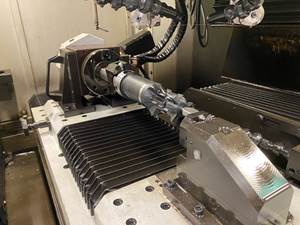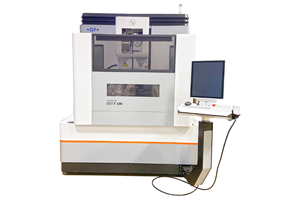Tips for Controlling Oxidation and Pitting on a Wire EDM
Additives, machine settings, workpiece materials and current technology are factors in avoiding common problems with unwanted rust and surface defects.
Share




Additives:
Additives do help in controlling oxidation and pitting of a variety of materials. These products help a great deal when cutting a workpiece with pre-polished surfaces.
Set the water conductivity to 5 microS or less, which is typically recommended for carbide, PCD, titanium, and fine finishes (<10 micro inches). This will also help keep bluing to a minimum on older non-anti-electrolysis generators.
Check water pH. Acidic detergents used to clean parts and tank will have a dramatic effect on parts rusting and will reduce the life of the deionization bottles.
Mix Workpiece Materials
With all the new and old types of alloys available, material incompatibility may cause surface issues. However, EDM field technicians have yet to document an instance where this situation has occurred.
New Machines
Most current wire EDMs are equipped with Anti-Electrolysis generators, some better then others. It basically comes down to how good the technology is and how fine of a surface finish the generator is capable of producing. A machine that is capable of producing a super fine finish (< 5 micro inches) can generate optimum surface integrity.
One example is the GF AgieCharmilles CUT 1000 that can machine parts with zero corrosion. The CUT 1000 is available in an oil version. With this feature, there is absolutely no electrolysis, corrosion and virtually zero recast.
Related Content
MWI Introduces Wire EDM Consumables Designed to Maximize Energy Efficiency
Blac Technology’s specialized composition is designed to provide uniform distribution and embedding of particles throughout the surface.
Read MoreDielectric Oil Dramatically Reduces EDM Maintenance
Plagued by repeated small fires that interrupted its wire EDM throughput, this cutting tool manufacturer changed its dielectric oil and both eliminated fires and reduced its oil consumption.
Read MoreBelmont Small-Hole EDM Features Multitasking Capabilities
The SY-4060 provides automatic depth control, three-step control of EDM parameters and conversational G- and M-code programming.
Read MoreGF Machining Solutions Wire EDM Features Improved Thermal Stabilization
The Cut F 600 wire EDM features machining enhancements and functions to automatically identify and adapt wire speed during the wire EDM process.
Read MoreRead Next
Building Out a Foundation for Student Machinists
Autodesk and Haas have teamed up to produce an introductory course for students that covers the basics of CAD, CAM and CNC while providing them with a portfolio part.
Read More5 Rules of Thumb for Buying CNC Machine Tools
Use these tips to carefully plan your machine tool purchases and to avoid regretting your decision later.
Read MoreRegistration Now Open for the Precision Machining Technology Show (PMTS) 2025
The precision machining industry’s premier event returns to Cleveland, OH, April 1-3.
Read More



























